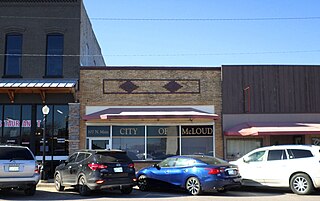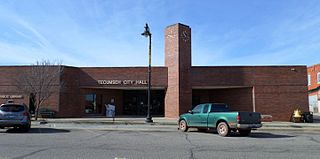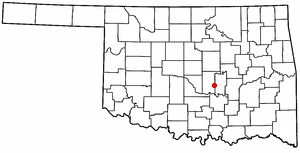
Seminole County is a county located in the U.S. state of Oklahoma. As of the 2020 census, the population was 23,556. Its county seat is Wewoka. Most of the county was a reservation for the Seminole Nation of Oklahoma which still retains jurisdiction over some land in the county. A small portion of land at the eastern end of the county belonged to the Muscogee (Creek) Nation.

Pottawatomie County is a county located in the U.S. state of Oklahoma. As of the 2020 census, the population was 72,454. Its county seat is Shawnee.
Asher is a town in Pottawatomie County, Oklahoma. The population was 393 at the 2010 census, a decline of 6.2 percent from the figure of 419 in 2000.

McLoud is a city in northwestern Pottawatomie County, Oklahoma, United States, and is part of the Oklahoma City Consolidated Metropolitan Area. The population was 4,044 at the 2010 census, a 14.0 percent increase from the figure of 3,548 in 2000. The city was founded in 1895 and named for John W. McLoud, attorney for the Choctaw, Oklahoma and Gulf Railroad.

Pink is a town in Pottawatomie County, Oklahoma, United States, and is part of the Oklahoma City Metropolitan Area. The only town in the United States bearing this name, Pink lies within the boundaries of the Citizen Potawatomi Nation. The 2010 census population was 2,058, a 76.7 percent increase from the figure of 1,165 in 2000.

Shawnee is a city in and the county seat of Pottawatomie County, Oklahoma, United States. The population was 29,857 in 2010, a 4.9 percent increase from the figure of 28,692 in 2000. The city is part of the Oklahoma City-Shawnee Combined Statistical Area and the principal city of the Shawnee Micropolitan Statistical Area.
St. Louis is a town in Pottawatomie County, Oklahoma, United States. The population was 158 at the 2010 census, a 23.3 percent decline from the figure of 206 in 2000.

Tecumseh is a city in Pottawatomie County, Oklahoma. Its population was 6,457 at the 2010 census, a 5.9% increase from 6,098 in 2000. It was named for the noted Shawnee chief, Tecumseh. It was designated as the county seat at Oklahoma's statehood, but a county-wide election moved the seat to Shawnee in 1930.

Konawa is a city in Seminole County, Oklahoma, United States. The population was 1,298 at the 2010 census. Konawa is a Seminole word meaning, "string of beads."

Wewoka is a city in Seminole County, Oklahoma, United States. The population was 3,271 at the 2020 census. It is the county seat of Seminole County.

Maud is a town on the boundary between Pottawatomie and Seminole counties in the U.S. state of Oklahoma. The population was 1,048 at the 2010 census, a 7.8 percent decrease from the figure of 1,136 in 2000. The town was named for Maud Stearns, a sister to the wives of two men who owned the first general store.

Sacred Heart is a small unincorporated community in Pottawatomie County, Oklahoma, United States. Established in 1879 by Father Isidore Robot as a Catholic mission on the old Pottawatomie reserve, it was originally named Sacred Heart Mission. The name was changed to Sacred Heart in 1888, shortly before the area was opened to settlement by non-Indians.

Meg Randall was an American film actress. She was active in motion pictures, radio, and television between 1946 and 1961, changing her name from Gene Roberts to Meg Randall in mid-1948.

State Highway 39, abbreviated as SH-39, is a state highway in the U.S. state of Oklahoma. It is 68.4 miles (110.1 km) in length. It runs east–west through the central part of the state, beginning at unincorporated Tabler, east of Chickasha, and ending east of Konawa. Along the way, SH-39 serves the counties of Grady, McClain, Cleveland, Pottawatomie, and Seminole. It currently has no lettered spurs.

State Highway 56 is a state highway in the U.S. state of Oklahoma. The road serves Seminole County, Okfuskee County, and Okmulgee Counties in central and east-central Oklahoma. In Seminole County, it is also designated as the Seminole Nation Highway in honor of the contributions the Seminole Nation has made to the state of Oklahoma.
Avoca Township was located in Pottawatomie County, Oklahoma. It should not be confused with Avoca, which was a smaller community inside the township.
The Choctaw, Oklahoma and Gulf Railroad (CO&G), known informally as the "Choctaw Route," was an American railroad in the states of Arkansas and Oklahoma.
Keokuk Falls is a ghost town in Pottawatomie County, Oklahoma. The location is 4.5 miles north and 15 miles east of Shawnee, as well as one mile west of the Creek Nation and one mile north of the Seminole Nation across the North Canadian River. It was named after Chief Moses Keokuk (1821-1908). He is buried in Stroud, Oklahoma's Sac and Fox cemetery.
Vamoosa is a populated place in Seminole County, Oklahoma. It is east-northeast of Konawa Reservoir, and less than 6 miles east-northeast of the town of Konawa, Oklahoma. It is situated just east of US Route 377 on EW140 Road. It had a post office from May 19, 1906 to March 20, 1918.
Little is a populated place in Seminole County, Oklahoma at an elevation of 968 feet. It is north of the City of Seminole and east of Shawnee, Oklahoma, located at the intersection of US Route 377 and Oklahoma State Highway 99A, just south of Interstate 40. It had a post office from August 14, 1902 to November 30, 1916. It was named for Thomas Little, a prominent Seminole and second chief of the tribe.










